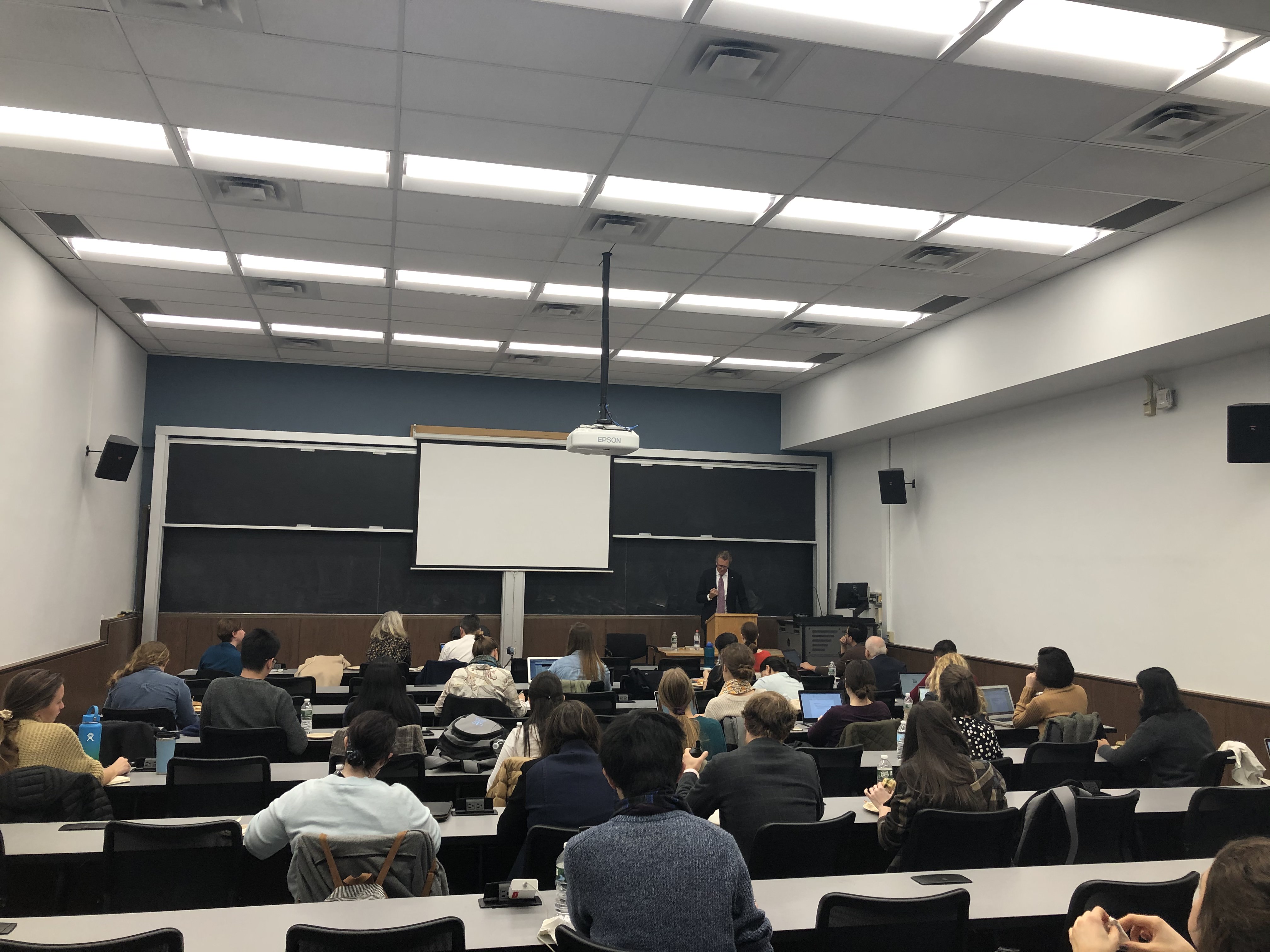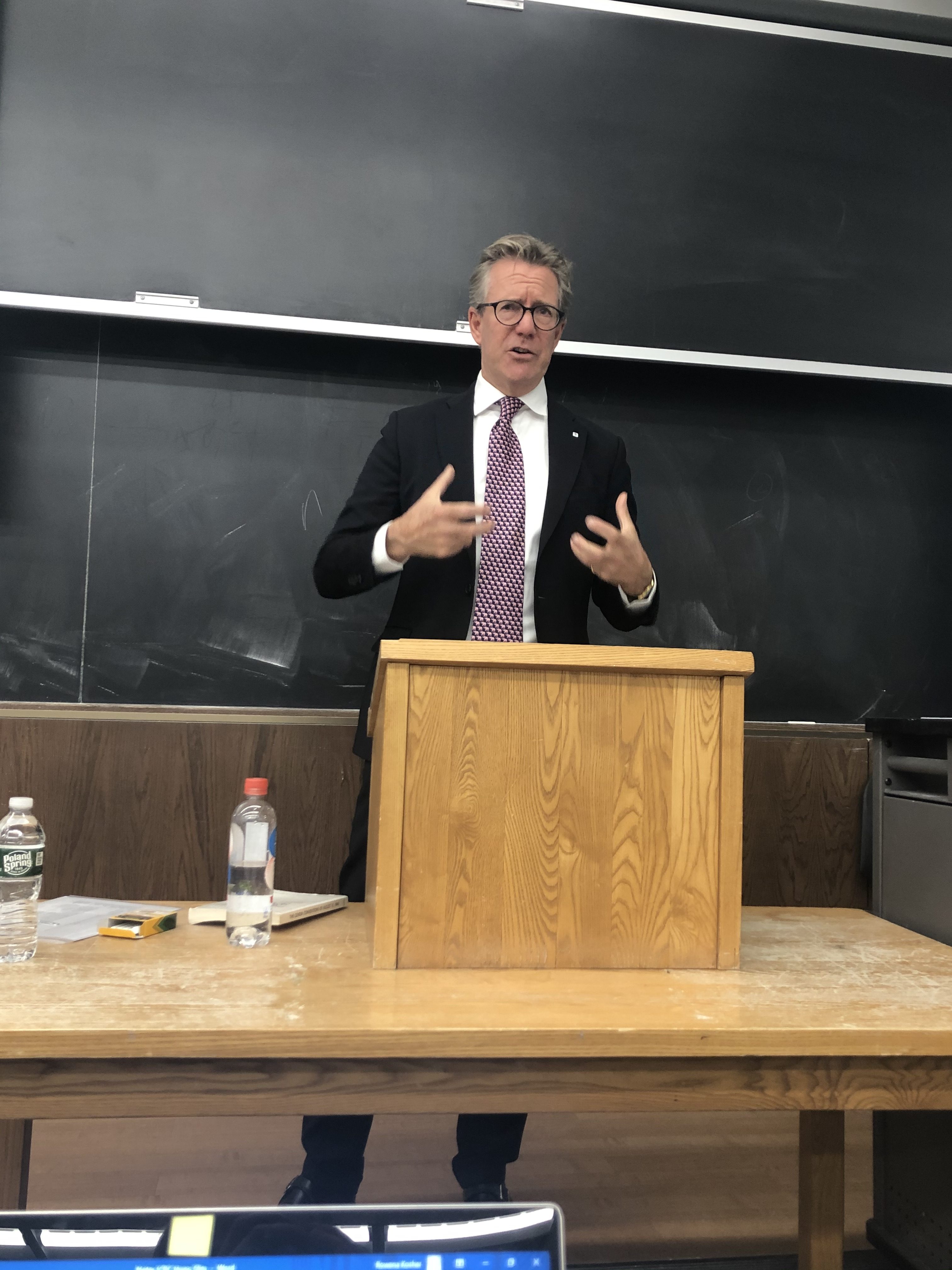By Rowena Kosher, Co-Editor of RightsViews
The International Committee of the Red Cross’ (ICRC) reverence for its mandate to the Geneva Conventions was obvious as Columbia students welcomed Hugo Slim, ICRC’s Head of Policy and Humanitarian Diplomacy Division, to speak on “War and Humanity: Challenges and Trends in the 70th Year of the Geneva Conventions” on November 6.

From its founding in 1863 in Geneva, the ICRC has been committed to the provision of international humanitarian aid, embedding itself as one of the core players in international humanitarian law (IHL) as it developed over time to regulate jus in bello, or the “conduct of war.” It was the ICRC that convinced states in 1864 to adopt the very first Geneva Convention, creating a universal obligation of care for all wounded soldiers. From that moment on, it was also the ICRC that ultimately headlined what the IHL community now holds as some of its most fundamental texts: the four Geneva Conventions of 1949 and their two 1977 protocols. These texts are the ICRC’s mandate, and as an organization, it holds them near and dear.

Dr. Slim, a renowned figure in the humanitarian world, began his presentation by holding up a book: a dog-eared, well-worn, coffee-stained text containing the language of the Geneva Conventions. This book, he began, started in 1949 with only 60 states having ratified it. Now, in 2019, 197 states have acceded to the Geneva Conventions, and many parts of it have become so intuitive that states understand them as pieces of customary, binding law. “[This book] is a moral, legal, and political achievement,” he articulated, “and a real high point of humanitarian multilateralism.”
And yet, although the Conventions are both an achievement and existing law, they are no less relevant today than they were during the World Wars. Slim described that these are texts that focus on violence and our response to violence—a reality that “continues to mark the human species in the present day.” Indeed, both the Conventions and the international environment face a changed world: one with more states parties, with more technology, with new mechanisms of warfare. All of this, he claimed, is vital to the ICRC fulfilling and furthering international humanitarian ethics.
To accomplish this task, Slim believes in beginning with a return to the text, asking “what does humanity look like in the Geneva Conventions?” If the ICRC is mandated to protect humans in wartime, who does it serve, to what ends, and in what philosophical conception?
On the most basic level, Slim said, the Geneva Conventions conceive of four groups of “protected persons:” the wounded and sick, the wounded at sea, prisoners of war, and civilians. These are the  explicitly articulated classes of the legal text. Yet, the Conventions go beyond this to articulate protection of certain human relationships and human objects; relations or things that the texts deem “necessary to be fully human.” The relationships that the Conventions protect include family and the idea of “being with others in this world and not just being alone.” Objects essential to human survival, such as food, water, medicine, and business, also get recognition. On a cultural level, Slim argued that the Conventions protect objects essential to human meaning, from religious objects and sites to cultural property, such as libraries and historic art. To go even further, he noted that the environment enjoys protections of its own in the Conventions, receiving a legal personality by virtue of the fact that in order to be human, one needs the environment.
explicitly articulated classes of the legal text. Yet, the Conventions go beyond this to articulate protection of certain human relationships and human objects; relations or things that the texts deem “necessary to be fully human.” The relationships that the Conventions protect include family and the idea of “being with others in this world and not just being alone.” Objects essential to human survival, such as food, water, medicine, and business, also get recognition. On a cultural level, Slim argued that the Conventions protect objects essential to human meaning, from religious objects and sites to cultural property, such as libraries and historic art. To go even further, he noted that the environment enjoys protections of its own in the Conventions, receiving a legal personality by virtue of the fact that in order to be human, one needs the environment.
Humanity, then, in the Geneva Conventions, is holistic. Slim said “To be alive is a matter of biology, but to live a life of dignity, one that is truly human, requires relationships and means of survival.” The Conventions move beyond the physical life into the communal life, beyond the human into the earth. He claimed that humanity becomes physical, emotional, and spiritual as the Conventions likewise function as a combination of law, military manual, social work guidance, and administrative guidance. Under their five action distinctions (precaution, distinction between soldier/civilian/object, proportionality, impartial relief, and human treatment), the Geneva Conventions enact their vision of humanity within the context of armed conflict.
Slim’s main priority as the policy director of ICRC requires that he operationalize the Conventions’ vision of humanity in the present day, addressing the trends and challenges that have cropped up in our changing world. In this lecture, he listed several major strategic shifts worldwide that he sees as most pressing for the ICRC and the Geneva Conventions, as they attempt to accomplish their goals for humanitarian aid.
Political Change

A total of 133 new states have acceded to the Conventions since 1949. The vast majority of these new parties are formerly colonized nations taking their rightful places on the world stage. This has challenged the “older” approach to global policy in which negotiations were a discussion among “like-minded states.” Now, Slim said, we live in a multipolar political environment. As such, the ICRC must answer with “multipolar diplomacy,” focusing on extending its network with a “multipolar footprint” and “network of multipolar relationships.”
A Radical Conservative Wave
In recent years, a radical conservative wave has swept through many parts of the world, from the US to the UK to India. Slim recognized that it can be tempting to dismiss conservative nations, however, the ICRC must find new ways of relating with conservative nations when it comes to international aid. In order to fulfil its mandate, the ICRC hopes to practice “humanitarian diplomacy” so as to find areas of ethical overlap between the principles of the Geneva Conventions and traditional conservative values. We need to “find a genuine humanitarian contract,” he argued.
Changing Warfare
The security situation in 2019 is marked by several differences compared to 1949. To start, Slim explained, militaries as of the past few years have developed so-called “near peer conflict worries,” concerned about growing threats from fellow Great Power “peers” developing into another Great Power conflict. Such a conflict would change the field of humanitarian aid immensely.
In addition, the ICRC has observed increased salience of coalition warfare, resulting in a complicated mix of states and armed groups as partners in armed conflicts. This has repercussions for the Geneva Conventions. Not all partners may be party to the treaty, leading to inconsistent adherence to IHL amongst coalitions themselves. The ICRC is currently working on an initiative to ensure IHL respect by all partners to a collation, Slim said, although it is not yet clear that it will succeed.
Lastly, the ICRC is paying close attention to the implications of the rise in urban warfare, which brings along with it particular worries about technology and the use of explosive weapons in densely populated areas. There are unique concerns to think about when a method of war may involve the ability to sabotage entire electrical grids or stop entire cities. In order to protect civilians, the ICRC has an initiative asking states to agree to a policy of non-use of explosive weapons in highly populated areas unless under real military necessity.
Weapons old and new
The ICRC has had strong stances on the use of highly destructive weapons of war since its founding. Of the “old” weapons the ICRC has always, since 1945, advocated for the abolition of nuclear weapons. “There is no way to use a nuclear weapon which is in compliance with this book,” he noted, holding up his copy of the conventions. Just because they have been around for a while, we cannot let nuclear weapons slip into history, he added. The ICRC will maintain its anti-nuclear position.
New weapons, however, also need to be addressed. The ICRC is particularly concerned about digitalization, autonomy, artificial intelligence, and deep learning technologies, which have put weapons systems on “the cusp of a major revolution,” according to Slim. Great powers are in a technological arms race, and the unfortunate paradox of this is that no one wants to begin anti-proliferation negotiation until they have already become the proverbial “winner”; thus the present day finds us in an utter freeze of negotiations. For the ICRC, Slim described a present focus on ethical arguments, attempting to articulate what the proper use of these weapons would be. Slim sees the policy of maintaining human control as key to addressing future high tech weapons.
Protracted Conflict and Fragility
Many conflicts today have been going on for decades, not to mention the continued effects felt from post colonization, he said. Short- and long-term work is important in protracted conflict. He believes the ICRC should stay aware of the nexus between humanitarian development and peace, along with the fact that this requires dedication to a multi-year investment so as to have “sustainable humanitarian impact.”
Climate and Conflict
Slim noted that the ICRC sees a growing trend in the number of people who are dealing with simultaneously conflict and climate shocks. “What does it mean to live with both these profound risks at one time? What does this mean for ICRC’s actions?” he asked, and then noted the ICRC’s intent to green itself as an institution.
People’s participation and a shift in humanitarian agency

Humanitarian aid has a history of a colonial mindset on the part of aid-givers to aid-receivers. Recognizing the ICRC’s complicity in this history, Slim articulated the need to change the grammar of aid. Rather than the patriarchal, patronizing “subject-verb-object” form of WE help YOU, humanitarian grammar must become more prepositional: “YOU are surviving, YOU are the subject of your lives, YOU are amazingly surviving with help from us.” This new approach, beyond grammar, is intersectional in intent, with the goal of giving more power to people in organizing and discussing what is best for them, rather than imposing assumed needs.
In addition to participation from those receiving aid from ICRC, Slim noted that donors increasingly want a say in how their funds are distributed by the organization. Trust, which will be the main focus at the ICRC’s upcoming December conference in Geneva, takes on two forms: operational trust and accountability. The ICRC must find a balance between compliance systems and a principle of trust with its donors, remembering that at the heart of this relationship is risk-sharing. “If you want to be in the game of helping people,” Slim said, “you will have to risk something.”
What does it matter that these trends be examined? How do the Geneva Conventions translate to today’s day and age? These are crucial questions that interrogate the philosophical, practical, and human implications of war. Despite the forward progression of time, war and violence remain as high as ever, though somewhat changed in modality and nature. Humanitarian aid remains necessary. The Geneva Conventions are certainly well-worn, but they are also a living document, requiring the constant re-investigation and re-interpretation by states, parties to conflict, and aid providers like the ICRC.
